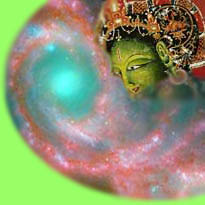|
The Short Commentary on the Tantra of Twenty-one Homages to Tārā called “The Treasure Vase of by Thupten Shedrub Gyatso. |
The Tārā of the
|
|||||||||||||||||||||
|
9
|
namas triratna-mudrâṅka-hṛdyâṅguli-vibhūṣite | bhūṣitâśeṣa-dik-cakra-nikara-sva-karâkule || namaḥ (n/V) – adoration, homage; triratna (n) – the three jewels; mudrā – seal; aṅka (m) – a hook, a curve, figure above the hip; hṛdya (n) – heart; aṅguli (f) – finger, toe, thumb; vibhūṣite – adorned, decorated; bhūṣita – adorned; aśeśa – all; dik-cakra (n) – the compass, the whole world; nikara (m) – heap, bundle, collection; svakara (m) – sva – own; kara (m) – ray of light, beam; ākule – confused, [ic:] overburdened with. Homage to you, who holds your fingers marvellously In the mūdra symbolizing the Triple Gem at your heart. Swirling masses of light adorn you, Permeating every direction in beautiful circles. The ninth praise is homage to Sengdeng Nagi Drolma,Tib the “Tārā of the The eight kinds of fears are: 1. The fear of elephants represents the power of ignorance. When ignorance grows strong, one ignores the law of cause and effect, indulges in alcohol, (here the use of alcohol is a symbolic of wrong view) and becomes crazy. 2. The fear of iron chains symbolizes habituation to lust and desire that bind together the senses and their objects. 3. The fear of piśāca demons signifies the doubt that steals the life force of nirvāṇa, as it moves in the sky of ignorance, and the doubt that harms the understanding of ultimate meanings. 4. The fear of rivers (floods) is a symbol of desire, acting savagely. By the possession of spirits, the current of desire carries beings towards saṃsāra in its tumultuous waves of birth, sick, aging and death caused by karmic wind. 5. The fear of fire represents the power of anger that burns the forest of virtue. Anger is the cause of anxiety, which in turn causes quarrels, disputes, and partialities. 6. The fear of robbery corresponds to the wrong views that steal the treasure of the supreme goal. This causes one to wander aimlessly in the barren ground of wrong view, (and to) believe in extremes and low ascetic practices. 7. The fear of reptiles represents jealousy, the poison of intolerance of another person’s prosperity. Jealousy results in everything becoming a cause for agitation. 8. The fear of lions. Signifies pride, the conceit of holding high ones own views and conduct. Pride causes one to (metaphorically) develop claws as sharp as a lion’s to belittle others. These and their casual factors are the eight fears. Another set of eight fears, which are the fruition of secondary afflictions are: 1. The fear of punishment by kings caused by self-infatuation and harming others. 2. The fear of foes is caused by hypocrisy, gloom, sloth and excitement. 3. The fear of evil spirits is caused by dishonesty and deceit. 4. The fear of leprosy is caused by lack of shame and dread of blame. 5. The fear of being lonely is caused by disbelief. 6. The fear of poverty is caused by stinginess. 7. The fear of thunder is caused by anger and enmity. 8. The fear of failure is caused by indolence and carelessness. Homage is paid to the lady who protects us from these two sets of fears. The inner meaning is that her wheel of the three primordial wisdom-minds, (the wisdom-minds of emptiness, clarity and compassion, illustrated by the mūdra symbolizing the Triple Gem) eliminates the nine bonds and other afflictions, which is a cause for accomplishing the fearless vajra of self-cognized luminosity. 1 Triple Gem ~ Buddha, Dharma and Saṅgha. Buddha as the teacher of refuge, the doctrine as actual refuge, and the spiritual community as support for practice. |
|||||||||||||||||||||
|
|

